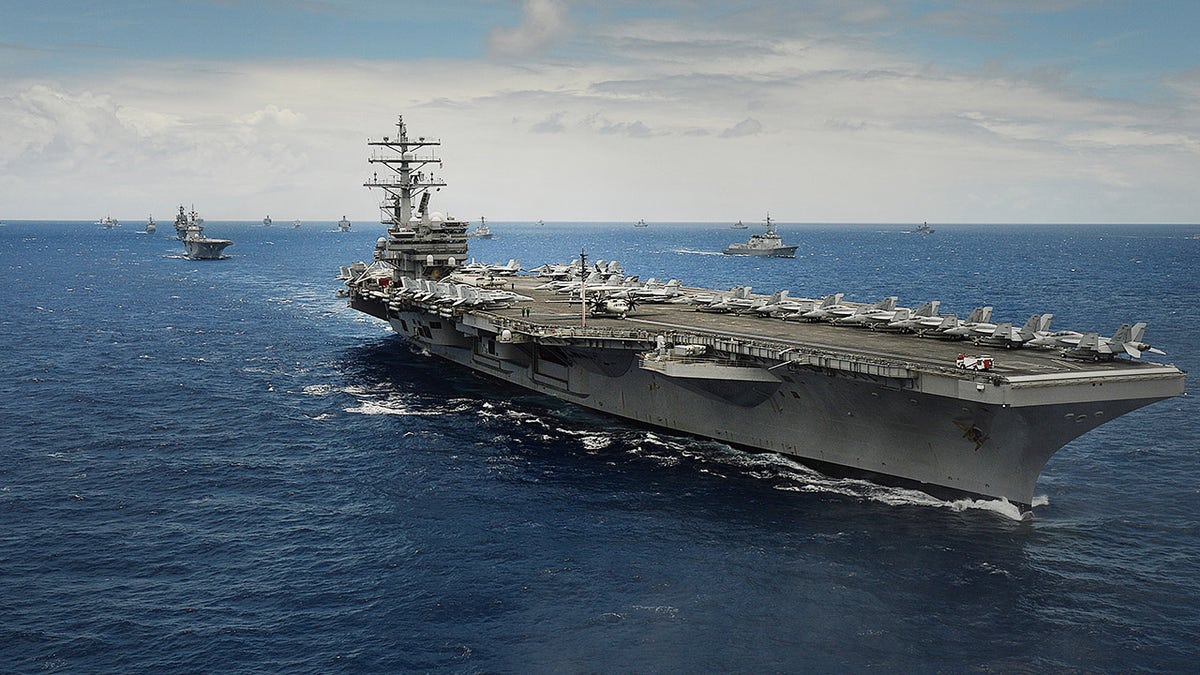Trumps aircraft carrier visit sends China a message: US sea power still rules the waves
The sight of President Donald Trump on the flight deck of the aircraft carrier USS George H. W. Bush was a great reminder that no one fears U.S. aircraft carriers more than China.Trump flew onto the carrier, underway in the Atlantic, as part of the Navys 250th Anniversary celebrations. He brought along First Lady Melania Trump, wearing a sleek leather flight jacket and more importantly, closed-toe, low-heel shoes, per Navy regulation for personnel on the flight deck. Together they watched a firepower demonstration from F/A-18EF Superhornets, F-35C fighters and the Aegis destroyers of the strike group in the Navys Atlantic training range.Later, Trump applauded carrier operations, with a speech back at the pier at Norfolk Naval Base, Virginia. "They land screaming jets on pitching decks in the dark of night with no room for error," he said.'ABSOLUTELY INCREDIBLE': B-2 BOMBER, F-35 ESCORT SET STAGE FOR TRUMP-PUTIN TALKS IN ALASKADespite this praise, Trumps visit actually marks something of a turnaround in the future of aircraft carriers. No question, Trump knows the value of aircraft carriers. In March, Trump paired up two carriers, the USS Harry S. Truman and USS Carl Vinson, to hit over 1,000 Houthi targets in Yemen. Operation Rough Rider "unleashed American fury on the Houthi terrorists in the Red Sea," Trump said Sunday, and included "the single largest airstrike from an American aircraft carrier." Last week, the Navys newest carrier, the USS Gerald R. Ford, was in the Baltic Sea staring down Russia.However, carriers hit rough seas in the Pentagon reviews carried out after Trumps inauguration. Trumps team was shocked to find shipyard workforce gaps and post-COVID supply chain problems delaying carrier construction. Worse, Pentagon staff raised doubts about the role of aircraft carriers against China.Heres the scoop. Aircraft carriers are lethal. Carriers have a major fighting role in the Pacific, because they are the only mobile air bases.Oh sure, the Chinese want you to think they can find, target, hit and sink a carrier with a handful of their DF-26 or DF-21 missiles. True, Chinas missiles can hit the western Pacific and Guam. And the Chinese military built a life-size mock-up of a fake Nimitz-class aircraft carrier in the Chinese desert for target practice.But Chinas chances of hitting, let alone sinking, a U.S. aircraft carrier are slim.First, finding and hitting a moving target at long range is extremely difficult. Because they run on nuclear power without refueling, American aircraft carriers can move anywhere in a 700-mile area within 30 minutes. Thats a serious targeting problem for Chinese missiles firing at long range. Especially when the U.S. carriers are using deception and electronic warfare tactics to confuse missiles.As Trump saw on Sunday, aircraft carriers with their strike groups are well-protected from missile attack. "I sail with a mini-Golden Dome every day," one aviator recently remarked. U.S. Navy Aegis destroyers carry an array of air defense missiles and can tap satellites to track and hit maneuvering hypersonic missiles. On top of that, the new Ford-class carriers have ample power to carry laser weapons for close-in defense.Plus, aircraft carriers have a double hull and multiple watertight compartments which make them nearly impossible to sink. Want proof? Check out the Full Scale Shock Trials conducted on USS Gerald R. Ford with a 40,000-lb. underwater blast with live ordnance less than 75 yards from the carrier. China would have to fire 30 of its DF-21 missiles to equal that weight.The Chinese will run out of missiles before U.S. aircraft carriers run out of tactics.Upgrades are on the way. Next year, the carrier airwing finally gets "robot gas," courtesy of the MQ-25 Stingray, an unmanned refueling drone that will add 500 miles of range to Navy fighters.Even better, the Navy has a secret, long-range stealth fighter plane for the aircraft carrier ready to unveil. Ten years in the making, this plane the Navy calls "F/A-XX" for future "fighter-attack" has advanced engines to boost range and lethality. Congress has fully funded the plane, so everyone is just waiting on Secretary of War Hegseth, Deputy Secretary Stephen Feinberg and Navy Secretary John Phelan to award that contract.A pair of aircraft carriers in the Pacific loaded with F/A-XXs and MQ-25s can attack targets 24/7 from 1500 miles out.CLICK HERE FOR MORE FOX NEWS OPINIONThe firepower of carriers cant be beat. No wonder China has three carriers at sea and just started on a fourth carrier: a copy-cat of the Ford-class, including nuclear propulsion and angled decks.You see, high-volume carrier airpower demands an angled deck to launch and recover aircraft. Straight-deck carriers were fine for the propellor aircraft of World War II, but not for the jet age, as the Navy found out the hard way."I landed on a straight-deck carrier," retired naval aviator Captain Ed Grunwald, age 98, U.S. Naval Academy Class of 1950, told me. On one of his missions in the 1950s, "I had landed and was taxiing when my wingmans jet failed to catch a wire, hit the crash barrier, bounced over it and killed six sailors," Grunwald said. Angled decks prevent those accidents because a "bolter" plane whose hook does not trap one of the three deck wires can add power and safely go around.Aircraft carrier agility is more vital than ever and Xi Jinping of China knows it.




